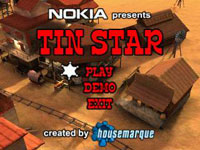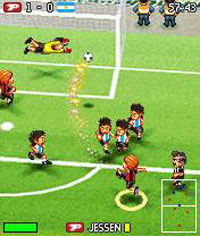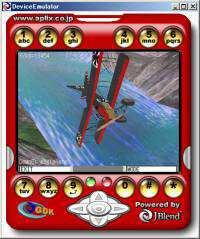T3Developing Mobile 3D Applications with OpenGL ES and M3G (Half-Day)

- Organizer
- Kari Pulli, Nokia Research Center & MIT CSAIL
- Speakers
- Kari Pulli, Nokia Research Center & MIT CSAIL
Tomi Aarnio, Nokia Research Center
Jani Vaarala, Nokia
Ville Miettinen, Hybrid Graphics
Mark Callow, HI Corporation
- Abstract
 This course presents two new 3D graphics APIs for mobile platforms:
OpenGL ES and M3G. Topics include the structure of the APIs, the evolution of
mobile graphics standards, programming examples, and tips and tricks for programmers
and artists. Attendees gain an understanding of the functionality the standards provide
and how to use them to create efficient graphics applications.
This course presents two new 3D graphics APIs for mobile platforms:
OpenGL ES and M3G. Topics include the structure of the APIs, the evolution of
mobile graphics standards, programming examples, and tips and tricks for programmers
and artists. Attendees gain an understanding of the functionality the standards provide
and how to use them to create efficient graphics applications.
- Summary
 Mobile phones offer exciting new opportunities for graphics application developers. However, they also
have significant limitations compared to traditional desktop graphics environments, including absence of
dedicated graphics hardware, limited memory (both RAM and ROM), limited communications bandwidth,
and lack of floating point hardware. Existing graphics APIs ignore these limitations and thus are
infeasible to implement in embedded devices.
Mobile phones offer exciting new opportunities for graphics application developers. However, they also
have significant limitations compared to traditional desktop graphics environments, including absence of
dedicated graphics hardware, limited memory (both RAM and ROM), limited communications bandwidth,
and lack of floating point hardware. Existing graphics APIs ignore these limitations and thus are
infeasible to implement in embedded devices.
 This course presents two new 3D graphics APIs that address the special needs and constraints of
mobile/embedded platforms: OpenGL ES and M3G. OpenGL ES is a light-weight version of the wellknown
workstation standard, offering a subset of OpenGL 1.5 capability plus support for fixed point
arithmetic. M3G, Mobile 3D Graphics API for Java MIDP (Mobile Information Device Profile), also known
as JSR-184, provides scene graph and animation support, binary file format, and immediate mode
rendering that bypasses scene graphs. These APIs provide powerful graphics capabilities in a form that
fits well on today's devices, and will support hardware acceleration in the future.
This course presents two new 3D graphics APIs that address the special needs and constraints of
mobile/embedded platforms: OpenGL ES and M3G. OpenGL ES is a light-weight version of the wellknown
workstation standard, offering a subset of OpenGL 1.5 capability plus support for fixed point
arithmetic. M3G, Mobile 3D Graphics API for Java MIDP (Mobile Information Device Profile), also known
as JSR-184, provides scene graph and animation support, binary file format, and immediate mode
rendering that bypasses scene graphs. These APIs provide powerful graphics capabilities in a form that
fits well on today's devices, and will support hardware acceleration in the future.
The course begins with a discussion of the target environments and their limitations, and general
techniques for coping with platform/environment constraints (such as fixed point arithmetic). This is
followed by detailed presentations of the APIs. For each API, we describe the included functionality and
compare it to related workstation standards, explaining what was left out and why. We also discuss
practical aspects of working with the APIs on the target platforms, and present strategies for porting
existing applications and creating new ones.
- Speakers' Background
-
- Kari Pulli
- has been an active contributor in both OpenGL ES and M3G (JSR-184) standardization
groups. Kari is a Research Fellow at Nokia and is currently a Visiting Scientist at MIT. Before joining
Nokia in 1999, Kari worked on graphics at Microsoft, SGI, and Alias|Wavefront, obtained a PhD at
University of Washington in graphics in 1997, and was the technical head of the Digital Michelangelo
project at Stanford Graphics Lab in 1998-99. Kari is a member of the Eurographics Executive
Committee.
- Jani Vaarala
- is a Graphics SW Architect at Nokia. He has been actively involved with OpenGL ES
standardization, and headed a project that developed a SW OpenGL ES engine and adapted EGL for
Symbian OS. Jani started on 3D graphics in early 90's on an Amiga, on which he developed several
award-winning graphics demos.
- Ville Miettinen
- is the CTO and co-founder of Hybrid Graphics, Ltd. During the last decade he has been
involved in the design and implementation of numerous software products in the games and 3D graphics
industries. His research interests include dynamic code generation and software rasterizers, and he has
authored conference and journal papers on graphics hardware and visibility optimization. He is a
member of ACM SIGGRAPH, the Khronos Group and the JSR-184 expert group.
- Tomi Aarnio
- is the specification editor and one of the main contributors in the M3G (JSR-184)
standardization group, and a member of the OpenGL ES group. As a Senior Research Engineer at
Nokia, he has been involved in designing and implementing several mobile graphics engines, most
recently heading the implementation of M3G.
- Mark Callow
- is Chief Architect at HI Corporation, the leader in 3D graphics engines for mobile devices,
whose Mascot Capsule Micro3D Engine is found on more than 30,000,000 handsets. Mark leads an
international team creating implementations of M3G and OpenGLES and was active in the creation of
both standards. Prior to HI, Mark was with Silicon Graphics for 11 years were he created InPerson, a
collaborative desktop video conferencing system; Mark was also Cosmo Software's liaison to the MPEG-
4 standards committee. He previously taught several well-received Siggraph courses and is a member of
ACM, ACM Siggraph, IEE, the Khronos Group and the JSR-184 expert group.
If you have any comments regarding this webpage please send a message to the webmaster.

 This course presents two new 3D graphics APIs for mobile platforms:
OpenGL ES and M3G. Topics include the structure of the APIs, the evolution of
mobile graphics standards, programming examples, and tips and tricks for programmers
and artists. Attendees gain an understanding of the functionality the standards provide
and how to use them to create efficient graphics applications.
This course presents two new 3D graphics APIs for mobile platforms:
OpenGL ES and M3G. Topics include the structure of the APIs, the evolution of
mobile graphics standards, programming examples, and tips and tricks for programmers
and artists. Attendees gain an understanding of the functionality the standards provide
and how to use them to create efficient graphics applications.
Mobile phones offer exciting new opportunities for graphics application developers. However, they also have significant limitations compared to traditional desktop graphics environments, including absence of dedicated graphics hardware, limited memory (both RAM and ROM), limited communications bandwidth, and lack of floating point hardware. Existing graphics APIs ignore these limitations and thus are infeasible to implement in embedded devices.
 This course presents two new 3D graphics APIs that address the special needs and constraints of
mobile/embedded platforms: OpenGL ES and M3G. OpenGL ES is a light-weight version of the wellknown
workstation standard, offering a subset of OpenGL 1.5 capability plus support for fixed point
arithmetic. M3G, Mobile 3D Graphics API for Java MIDP (Mobile Information Device Profile), also known
as JSR-184, provides scene graph and animation support, binary file format, and immediate mode
rendering that bypasses scene graphs. These APIs provide powerful graphics capabilities in a form that
fits well on today's devices, and will support hardware acceleration in the future.
This course presents two new 3D graphics APIs that address the special needs and constraints of
mobile/embedded platforms: OpenGL ES and M3G. OpenGL ES is a light-weight version of the wellknown
workstation standard, offering a subset of OpenGL 1.5 capability plus support for fixed point
arithmetic. M3G, Mobile 3D Graphics API for Java MIDP (Mobile Information Device Profile), also known
as JSR-184, provides scene graph and animation support, binary file format, and immediate mode
rendering that bypasses scene graphs. These APIs provide powerful graphics capabilities in a form that
fits well on today's devices, and will support hardware acceleration in the future.






















